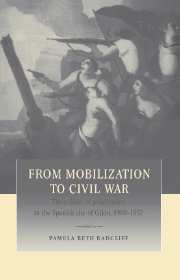Book contents
- Frontmatter
- Contents
- List of maps
- List of tables
- Acknowledgments
- Glossary of terms and abbreviations
- Introduction
- 1 A turning point: the city in 1900
- PART I Patterns of life in working-class Gijón
- PART II Institutional forces of opposition: republicans and anarchosyndicalists
- PART III Defining an oppositional culture: the struggle over the public sphere
- 7 Republican culture: a nation of citizens
- 8 Labor movement culture: the brotherhood of workers
- PART IV The urban battlefield: conflict and collective action, 1901–1936
- Conclusion
- Appendix 1 Wage and price movement
- Appendix 2 Occupations by status category
- Appendix 3 Supplementary tables
- Select bibliography
- Index
8 - Labor movement culture: the brotherhood of workers
Published online by Cambridge University Press: 31 October 2009
- Frontmatter
- Contents
- List of maps
- List of tables
- Acknowledgments
- Glossary of terms and abbreviations
- Introduction
- 1 A turning point: the city in 1900
- PART I Patterns of life in working-class Gijón
- PART II Institutional forces of opposition: republicans and anarchosyndicalists
- PART III Defining an oppositional culture: the struggle over the public sphere
- 7 Republican culture: a nation of citizens
- 8 Labor movement culture: the brotherhood of workers
- PART IV The urban battlefield: conflict and collective action, 1901–1936
- Conclusion
- Appendix 1 Wage and price movement
- Appendix 2 Occupations by status category
- Appendix 3 Supplementary tables
- Select bibliography
- Index
Summary
Like labor movements elsewhere, Gijón's Socialist and anarchist federations sought to create an alternative culture that brought their political ideals to life and instilled them into their working-class members. In addition to offering workplace protection, the trade union federation was to serve both as a training ground for the new society and as the nucleus for it. It was where workers experienced the basic principles of Socialist or libertarian philosophy. Here also, workers learned to rely on each other instead of on their bosses or the political elites, including sympathetic republicans. Mutual aid and reliance were fundamental building blocks of the future society, particularly for the anarchists, who envisioned a new order of independent communities. The labor movement's vision of an alternative culture can be encapsulated in the image of the brotherhood of workers, a family purged of its subordinate and authority figures, in which all were equal as they were bound together in the fraternity of their class. The contrast between the brotherhood of workers and the nation of citizens sums up the different orientation of republicans and labor militants, who defined identity through one's relationship to work.
Although fraternity began at the workplace, it was supposed to extend into all areas of public life. At the workplace, the union attempted to protect its members from unacceptable working conditions. When members fell ill, lost their jobs, or were evicted from their homes, they could turn to the union for support. Moreover, the union houses were not simply crisis centers.
- Type
- Chapter
- Information
- From Mobilization to Civil WarThe Politics of Polarization in the Spanish City of Gijón, 1900–1937, pp. 226 - 248Publisher: Cambridge University PressPrint publication year: 1997

